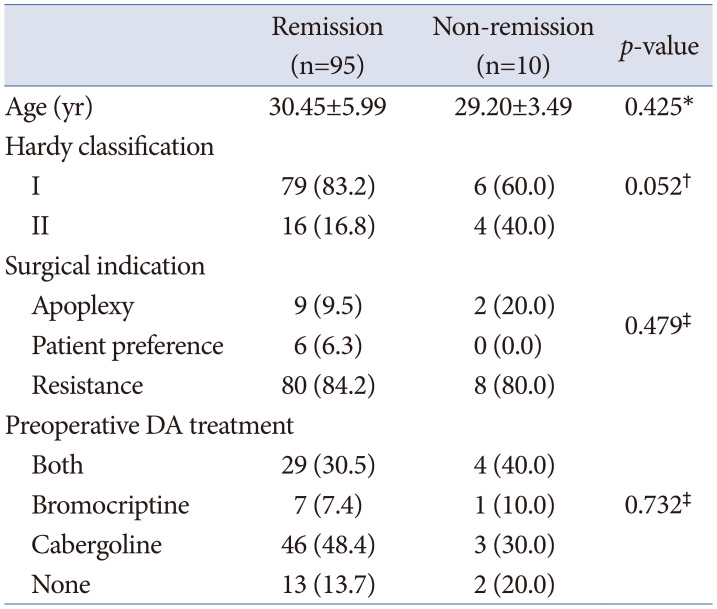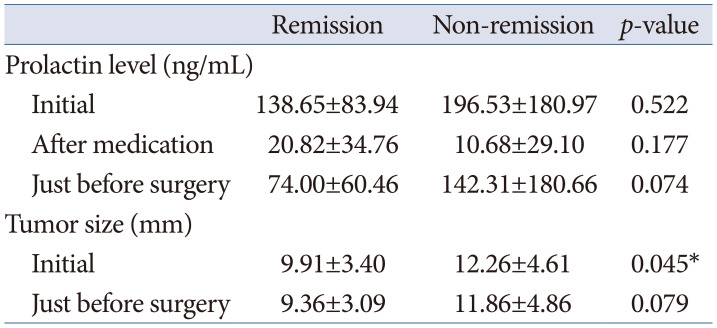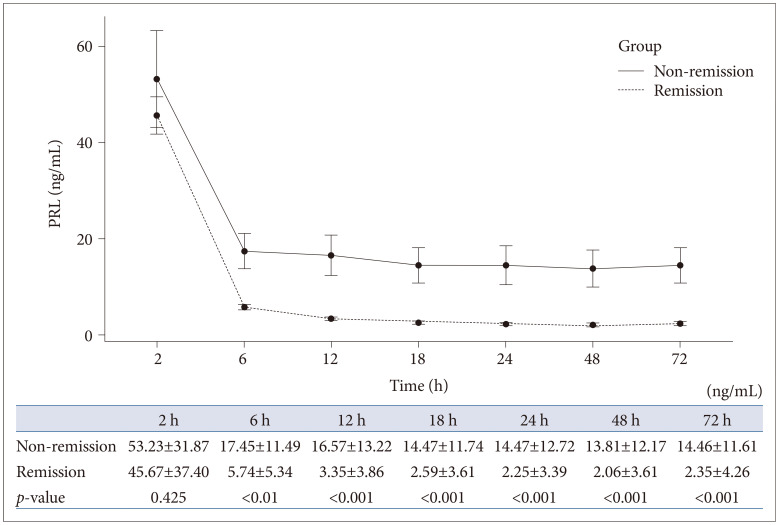1. Krysiak R, Okopień B, Marek B, Szkróbka W. [Prolactinoma]. Przegl Lek. 2009; 66:198–205. Polish. PMID:
19708510.
2. Ciccarelli E, Camanni F. Diagnosis and drug therapy of prolactinoma. Drugs. 1996; 51:954–965. PMID:
8736617.
3. Schlechte JA. Long-term management of prolactinomas. J Clin Endocrinol Metab. 2007; 92:2861–2865. PMID:
17682084.
4. Zamanipoor Najafabadi AH, Zandbergen IM, de Vries F, Broersen LHA, van den Akker-van Marle ME, Pereira AM, et al. Surgery as a viable alternative first-line treatment for prolactinoma patients. A systematic review and meta-analysis. J Clin Endocrinol Metab. 2020; 105:e32–e41. PMID:
31665485.
5. Andereggen L, Frey J, Andres RH, El-Koussy M, Beck J, Seiler RW, et al. 10-year follow-up study comparing primary medical vs. surgical therapy in women with prolactinomas. Endocrine. 2017; 55:223–230. PMID:
27688009.
6. Huber M, Luedi MM, Schubert GA, Musahl C, Tortora A, Frey J, et al. Machine learning for outcome prediction in first-line surgery of prolactinomas. Front Endocrinol (Lausanne). 2022; 13:810219. PMID:
35250868.
7. Park JY, Choi W, Hong AR, Yoon JH, Kim HK, Jang WY, et al. Surgery is a safe, effective first-line treatment modality for noninvasive prolactinomas. Pituitary. 2021; 24:955–963. PMID:
34189717.
8. Penn MC, Cardinal T, Zhang Y, Abt B, Bonney PA, Lorenzo P, et al. Cure and hormonal control after prolactinoma resection: case series and systematic review. J Endocr Soc. 2021; 5:bvab074. PMID:
34466765.
9. Gillam MP, Molitch ME, Lombardi G, Colao A. Advances in the treatment of prolactinomas. Endocr Rev. 2006; 27:485–534. PMID:
16705142.
10. Melmed S, Casanueva FF, Hoffman AR, Kleinberg DL, Montori VM, Schlechte JA, et al. Diagnosis and treatment of hyperprolactinemia: an Endocrine Society clinical practice guideline. J Clin Endocrinol Metab. 2011; 96:273–288. PMID:
21296991.
11. Ku CR, Kim EH, Oh MC, Lee EJ, Kim SH. Surgical and endocrinological outcomes in the treatment of growth hormone-secreting pituitary adenomas according to the shift of surgical paradigm. Neurosurgery. 2012; 71:ons192–ons203. PMID:
22743357.
12. Neal JH, Weiss MH. Management of prolactin-secreting pituitary adenomas. West J Med. 1990; 153:546–547. PMID:
2260295.
13. Molitch ME. Diagnosis and treatment of pituitary adenomas: a review. JAMA. 2017; 317:516–524. PMID:
28170483.
14. Paluzzi A, Fernandez-Miranda JC, Tonya Stefko S, Challinor S, Snyderman CH, Gardner PA. Endoscopic endonasal approach for pituitary adenomas: a series of 555 patients. Pituitary. 2014; 17:307–319. PMID:
23907570.
15. Losa M, Mortini P, Barzaghi R, Gioia L, Giovanelli M. Surgical treatment of prolactin-secreting pituitary adenomas: early results and long-term outcome. J Clin Endocrinol Metab. 2002; 87:3180–3186. PMID:
12107221.
16. Babey M, Sahli R, Vajtai I, Andres RH, Seiler RW. Pituitary surgery for small prolactinomas as an alternative to treatment with dopamine agonists. Pituitary. 2011; 14:222–230. PMID:
21170594.
17. Lee EJ, Ahn JY, Noh T, Kim SH, Kim TS, Kim SH. Tumor tissue identification in the pseudocapsule of pituitary adenoma: should the pseudocapsule be removed for total resection of pituitary adenoma? Neurosurgery. 2009; 64(3 Suppl):ONS62–ONS70. PMID:
19240574.
18. Oldfield EH, Vortmeyer AO. Development of a histological pseudocapsule and its use as a surgical capsule in the excision of pituitary tumors. J Neurosurg. 2006; 104:7–19. PMID:
16509142.
19. Ceylan S, Cabuk B, Koc K, Anik I, Vural C. Endoscopic distinction between capsule and pseudocapsule of pituitary adenomas. Acta Neurochir (Wien). 2013; 155:1611–1619. PMID:
23686633.
20. Qu X, Wang M, Wang G, Han T, Mou C, Han L, et al. Surgical outcomes and prognostic factors of transsphenoidal surgery for prolactinoma in men: a single-center experience with 87 consecutive cases. Eur J Endocrinol. 2011; 164:499–504. PMID:
21252173.
21. Alimohamadi M, Sanjari R, Shirani M, Alikhani F, Amirjamshidi A. Initial experience with diffusion-weighted imaging to predict the tumor consistency and surgical success in solid growth hormone producing pituitary macroadenomas. Asian J Neurosurg. 2019; 14:698–701. PMID:
31497087.
22. Melmed S. Mechanisms for pituitary tumorigenesis: the plastic pituitary. J Clin Invest. 2003; 112:1603–1618. PMID:
14660734.
23. Kim EH, Oh MC, Lee EJ, Kim SH. Predicting long-term remission by measuring immediate postoperative growth hormone levels and oral glucose tolerance test in acromegaly. Neurosurgery. 2012; 70:1106–1113. PMID:
22067418.
24. Kim SH, Ku CR, Na M, Yoo J, Kim W, Jung IH, et al. Immediate postoperative measurement of thyroid-stimulating hormone as an early predictor of remission in thyroid-stimulating hormone-secreting pituitary adenomas. J Neurosurg. 2020; 134:794–800. PMID:
32168476.
25. Amar AP, Couldwell WT, Chen JC, Weiss MH. Predictive value of serum prolactin levels measured immediately after transsphenoidal surgery. J Neurosurg. 2002; 97:307–314. PMID:
12186458.







 PDF
PDF Citation
Citation Print
Print




 XML Download
XML Download